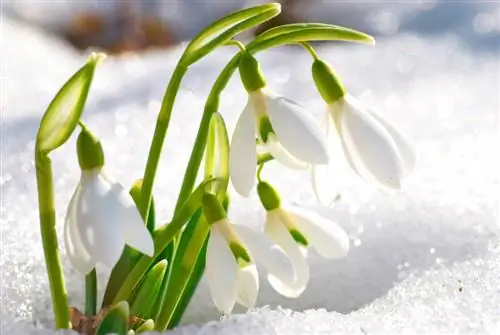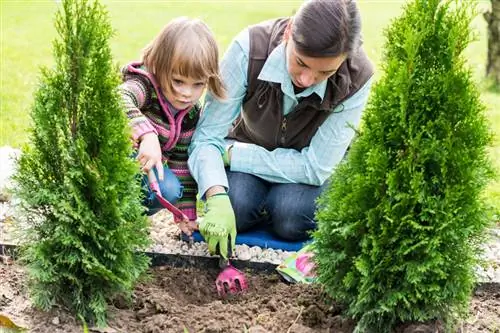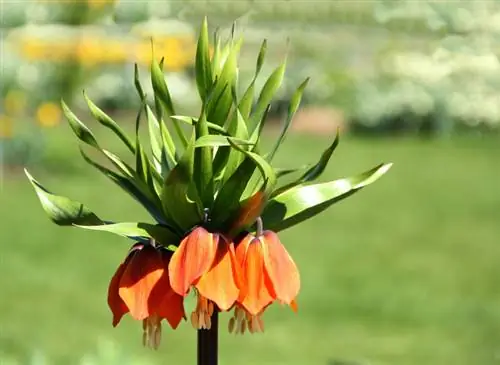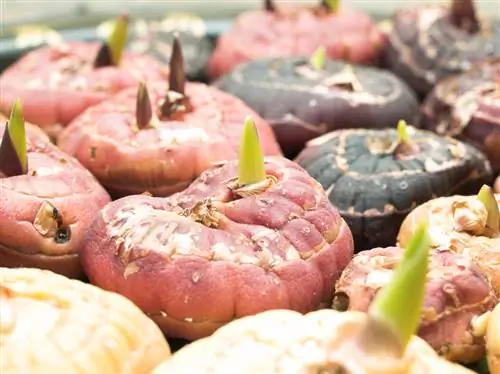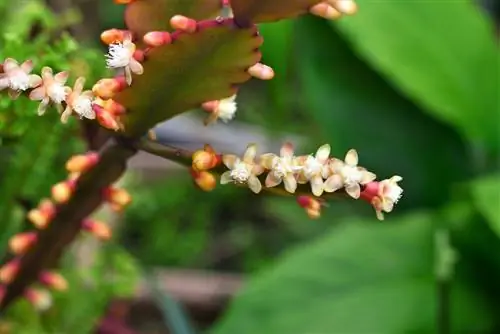- Author admin [email protected].
- Public 2023-12-25 17:45.
- Last modified 2025-01-23 11:22.
They venture out of cover when the garden is still in deep hibernation. Snowdrops spread a romantic spring atmosphere without requiring extensive care. The gardening tools for successful cultivation can be discovered here.

How to plant and care for snowdrops in the garden?
Snowdrops are hardy, perennial bulb flowers that bloom from January to May. They prefer partially shaded to shady locations, with fresh, moist and humus-rich soil. Planting time is from the end of August to the end of October, and they require very little care.
Planting snowdrops correctly
The window for planting snowdrops is open from the end of August to the end of October. The early bloomers develop optimally in a protected, semi-shady place in normal garden soil. Arrange the bulbs in small groups of 5. Place these 6-8 centimeters deep in the soil, at a distance of 5 centimeters. It is important to note that the onion tip is pointing upwards.
Suffering hobby gardeners plant their snowdrops in the vole basket (€15.00 on Amazon). For this purpose, a 15 centimeter deep hole is dug, the wire basket is inserted and the bottom is covered with 5 centimeters of sand. Only then do you plant the snowdrop bulbs in the loose, compost-enriched soil and water carefully.read more
Care tips
The care protocol of a snowdrop includes only these few factors:
- Watering when natural rainfall is insufficient
- Do not fertilize the bed
- Cut off the withered flower stems first, then the withered leaves later
- Plants in the vole basket prevent feeding damage
Snowdrop islands in the lawn may only be mowed when the leaves have completely yellowed. The early bloomers are usually spared from diseases.
Which location is suitable?
A look at the location in the wild reveals where snowdrops feel comfortable. They thrive in the shelter of tall deciduous trees, at the edge of the forest and wherever they are not exposed to direct sunlight. The perfect location in the garden should be like this:
- Partially shaded to shady lighting conditions
- Fresh, moist soil, rich in humus
- Soil with excellent drainage
The spring bells don't want to be confronted with an acidic pH value and waterlogged soil.read more
What is the best time to plant?
The planting season for snowdrops extends from the end of August to the end of October. If the weather is mild, there is nothing wrong with planting the flower bulbs in November.read more
When is flowering time?
If you cleverly combine the different types and varieties of snowdrops, you can extend the flowering period by several weeks. We have put together a list for you here when the most popular snowdrops present their white flowers:
- Little snowdrop: January to March
- Lake Riza snowdrop: end of January to beginning of April
- Double snowdrop: February to March
- Delicate and Caucasus Snowdrops: February to May
The wild species called Queen Olga snowdrop trumps its counterparts with a never-ending flowering period from October to March.read more
Cut snowdrops correctly
Pruning snowdrops takes place in two stages. First, cut off the withered flower stems so that the flower doesn't invest all its energy in growing seed heads. The leaves remain on the flower for some time so that the bulb can absorb the remaining nutrients. Only then are the scissors used.read more
Fertilize snowdrops properly
Snowdrops are among the typical self-sufficient plants in the bed. The additional application of fertilizer has a counterproductive effect here, as it results in a fattening of the leaves at the expense of the flowers. However, in the limited substrate volume of pots and flower boxes, fertilizing twice a day is an advantage. At the beginning and end of the flowering period, the snowdrop is happy about a portion of compost, guano or horn shavings.read more
Propagate snowdrops
Since a single snowdrop does not bring spring, the desire for uncomplicated propagation is understandable. How good that the flower makes an important contribution, as it ensures plenty of offspring in the form of daughter bulbs. After flowering, dig up several bulbs, separate the bulbs with a sharp knife and plant them in the new location.
In contrast, sowing seeds proves to be time-consuming and time-consuming. As cold germinators, the seeds first undergo stratification, whereby they are exposed to cold stimuli over several weeks. It takes up to 5 years for a seedling to develop into a beautifully blooming snowdrop.read more
How do I transplant correctly?
Transplanting snowdrops is particularly recommended during the flowering period. If the early bloomers are full of juice, they can cope with the stress better than at the end of the flowering period. How to do it right:
- Don't cut back the flowers
- Lift it out of the ground with the digging fork
- Plant 6-8 cm deep in the new, partially shaded location
In group planting, a planting distance of at least 5 centimeters is considered appropriate.read more
Snowdrops in a pot
Snowdrops in pots decorate semi-shady to shady places on the balcony, terrace or in the entrance to the house. To ensure that the early bloomers develop their perfect beauty in the planter, follow these steps:
- Use good compost-based potting soil as a substrate
- Create drainage over the water drain using gravel or pottery shards
- Insert the onions in small groups 6-8 centimeters deep in autumn
- The tips of the bulbs are directed upwards, with a planting distance of 5 centimeters
Keep snowdrops in the pot constantly moist. Fertilize with a little liquid fertilizer at the beginning and at the end of the flowering period.read more
Is snowdrop poisonous?
Snowdrops are slightly poisonous flowers because all parts of the plant contain alkaloids that are harmful to he alth. This is especially true for the onions. If small children are exploring in the garden, they should be made aware of the consequences of eating snowdrops. There is a risk of severe nausea, vomiting and stomach cramps.
The early bloomers pose a serious threat to pets, especially dogs, cats and rabbits. For dogs, for example, the critical dose is 2-3 onions. Symptoms of poisoning occur, such as vomiting, symptoms of paralysis and even cardiac arrest.read more
Profile
The profile provides a condensed overview of the snowdrop, full of valuable information for successful cultivation in beds and pots. The following facts stand out particularly clearly:
- Plant family: Amaryllis family (Amaryllidaceae)
- Perennial, hardy bulb flower
- 20-25 known species with more than 2,000 varieties
- Flowering period from January to May, depending on the species
- Growth height 2 to 25 cm
- Special feature: slightly poisonous in all parts
After the snowdrop immigrated to us from its Asian homeland, it found its way out of the gardens and became wild in the wild. The spring bell is now endangered here, so it has been placed under nature protection.read more
The peculiarities of the snowdrop
Snowdrops awaken a great passion for collecting. Every year, fans of the popular early bloomer gather for large snowdrop festivals in search of unique specimens. This is hardly surprising, given the individual characteristics:
- Snowdrops are under conservation protection
- The white flowers effortlessly break through even a blanket of snow
- The onions generate their own bioheat
- With daughter bulbs, they provide for their own offspring
- The slight poison content keeps predators away
read more
Snowdrops under nature protection
Since snowdrops are highly endangered in their population, the small flower beauties are subject to nature conservation. Therefore, any removal from their natural environment is punishable by heavy fines. In this regard, all European countries are pulling together.read more
The bulbs of the snowdrop
The delicate flowers of a snowdrop sprout from an underground survival organ in the shape of a bulb. Planted correctly, snowdrop bulbs repeat the small miracle of their spring blooms for many years. This is how it works in an exemplary manner:
- Dig small planting pits 8-10 centimeters deep
- Enrich the excavation with compost and a little sand
- Place the onions in small tuffs of 5 pieces each so that they do not touch each other
- The tip of a snowdrop bulb always points towards the sky
We recommend placing a vole basket in the pit before planting, as bulbs are at the top of the pests' menu.read more
Setting snowdrop bulbs
In order to plant snowdrop bulbs in an exemplary manner, no extensive previous knowledge is required. It's that easy:
- The planting pit is 8-10 centimeters deep
- Insert the onions in small groups with the tip pointing skyward
- The planting distance is 5 centimeters
Finally, press the soil with your hands and water with a fine spray.read more
The snowdrop blossom
The media is making us aware of the toxic content of snowdrops and their protected status. In order to be able to identify the flowers in the wild, the blossom serves as a visual identification feature:
- 3 white petals envelop 3 smaller, greenish-white petals
- Teardrop-like shape in all snowdrop species and varieties
- 2 groups with 3 cone-shaped stamens each
read more
Sowing snowdrop seeds
After flowering, a snowdrop invests all its strength in the growth of capsule fruits. It contains up to 36 seeds for the continuation of the genus. You can let nature take its course or harvest the seeds and sow them yourself. Here's how to do it:
- Put the washed seeds in a plastic bag with moist sand
- Store tightly closed in the vegetable compartment of the refrigerator for 4-6 weeks
- Sow germinating seeds in seed pots with peat sand
- Sift over with substrate and moisten with a fine shower gel
At a temperature of 15 to 18 degrees, keep the seedlings constantly moist in a partially shaded location. Plant the young snowdrops in the bed in autumn. It can take 3 to 5 years until the first flowering occurs.read more
The difference between snowdrops and lilies of the valley
At first glance, snowdrops and lilies of the valley look very similar. However, upon closer inspection these differences become clear:
- Snowdrops bloom from January/February - lilies of the valley only in May
- Snowdrops have a single, teardrop-shaped flower on each stem
- Lily of the valley thrives with 10 or more broad, bell-shaped flower clusters
The deviation of the leaves is obvious. While the foliage of snowdrops appears lanceolate and narrow, lily of the valley leaves grow up to 5 centimeters wide.read more
The snowdrop species
The snowdrop genus is populated with more than 20 beautiful species. In addition to the widespread common snowdrop (Galanthus nivalis), the large-flowered snowdrop (Galanthus elwesii) and the Crimean snowdrop (Galanthus plicatus) often thrive in our gardens.read more
The most beautiful varieties
- Large-flowered snowdrop: the Galantus elwesii blooms as one of the first snowdrop varieties
- Flore Pleno: enchants with lush double flowers and wonderful scent from February to March
- Sam Arnott: a gem among the snowdrop varieties with particularly large flowers
- Viridapice: characterized by long white petals with green tips
- Hippolyta: impresses with double bell-shaped flowers made of white, delicate green bracts
- Anglesey Abbey: a rare variety with petals of equal length
- Wendy Gold: valuable collector's variety with white bracts and yellow crown
- Titania: romantic snowdrop with white frilly flowers

